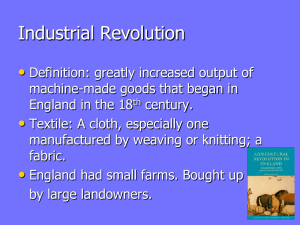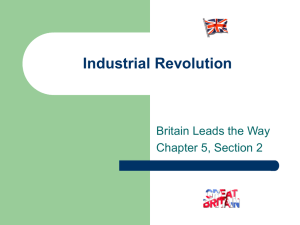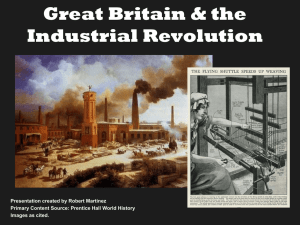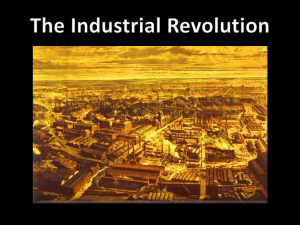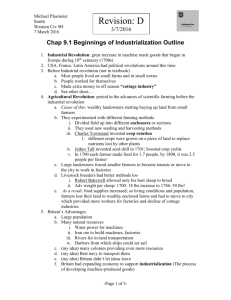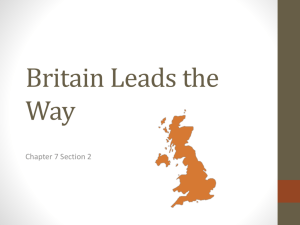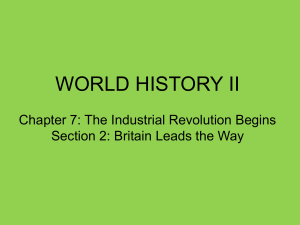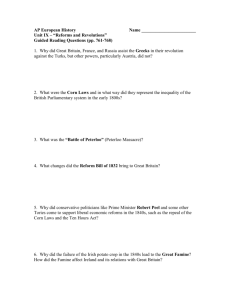Ch7Sec2
advertisement
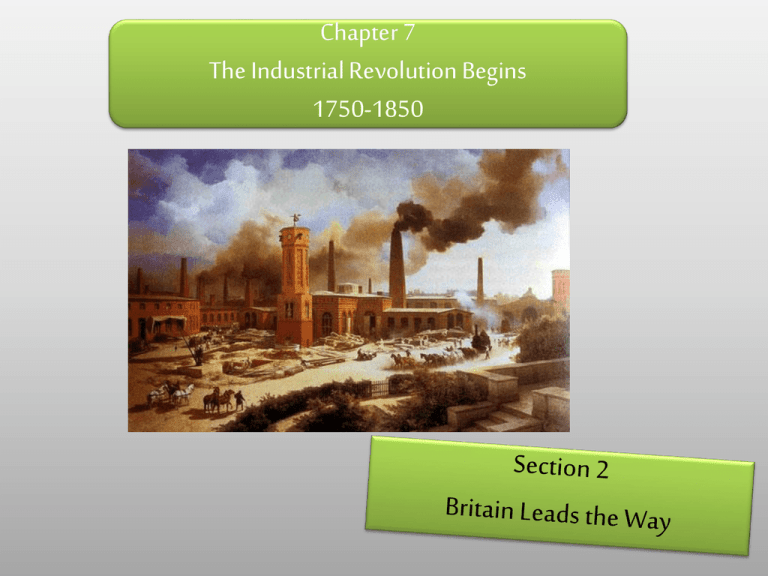
Chapter 7 The Industrial Revolution Begins 1750-1850 Objectives for this section: *Understand why Britain was the starting point for the Industrial Revolution. *Describe the changes that transformed the textile industry. *Explain the significance of the transportation revolution. Britain Leads the Way Two major factors led to a population boom in the cities of England during the mid 1700s. 1. The Agriculture Revolution increased food production. The food fueled growth and good health. People were living longer. 2. Agricultural changes left many farmers homeless and jobless. These farmers migrated from the rural villages to the big cities of England in order to find jobs. This population increase created a supply of labor to mine the coal, build the factories, and run the machines. Why Britain? Natural Resources Britain had the advantage of having many natural resources. One of their most important resources was their waterways. The country is full of rivers and ports which supplied water power and allowed for the construction of canals. The canals increased trade and were vital to the transportation of goods. Since Britain is an island, transporting goods to other countries was not only easy but also cheap. Britain also had a large supply of coal which was used to power steam engines and iron which was used to build new machines. The Effects of Demand and Capital In the 1700s, Britain had plenty of skilled mechanics who were eager to meet the growing demand for new practical inventions. This ready workforce, along with the population explosion, boosted demand for goods. Money was also necessary to start businesses. From the mid-1600s though the 1700s, trade from a growing overseas empire helped the British economy prosper. The British slave trade earned capital, which is money used to invest in enterprises. An enterprise is a business organization in an area such as shipping, mining, railroads, or factories. Britain also had a stable government that supported economic growth and encouraged entrepreneurs (those who managed and assumed the financial risks of starting new businesses). The government built a strong navy that protected its empire, shipping, and overseas trade. The Textile Industry Advances The biggest money maker for the British during the Industrial Revolution was the textile industry. In the 1600s, cotton cloth imported from India had become popular. British merchants developed the putting-out system. Putting-out system: Raw cotton (sent to) poor families who spun it into thread and wove the thread into cloth (sent to) skilled artisans in the towns who finished and dyed the cloth. Inventions Speed Production The demand for cloth was increasing and the putting-out system was slow and inefficient. Several inventors came up with several devices that revolutionized the British textile industry. John Kay’s Flying Shuttle (1733): Enabled weavers to work so fast that they soon outpaced spinners. James Hargreaves’ Spinning Jenny (1764): Spun many threads at the same time. Richard Arkwright’s Water Frame (1769): Spinning machine that could be powered by water. Eli Whitney’s Cotton Gin (1793): Separated the seeds from the raw cotton at a fast rate. Factories are Born in Britain The new machines doomed the putting-out system. The machines were too large and expensive the be operated at home. Instead, manufactures built long sheds to house the machines. At first, they located the sheds near rapidly moving streams, harnessing the water power to run the machines. Later machines were powered by steam engines. Spinners and weavers now came each day to work in these first factories, which brought together workers and machines to produce large quantities of goods. These factories were able to produce much more than the putting-out system ever could. The Transportation Revolution- As production increased, entrepreneurs needed faster and cheaper methods of moving goods from place to place. *Turnpikes- private roads built by entrepreneurs who charged travelers a toll, or fee to use them. These roads linked every part of Britain together. *Build canals (man-made waterways used for transporting goods and/or people). They connected rivers together. This became very popular until they were replaced by the railroads. *In the 1800s, George Stephenson developed steam-powered locomotives to pull carriages along iron rails. Tracks could go places that rivers and canals could not. By 1870, rail lines crossed Britain, Europe, and North America. *Built stronger bridges/upgraded harbors helped overseas trade. One Thing Leads to Another As the Industrial Revolution got under way, it triggered a chain reaction: *Inventors developed machines that could produce large quantities of goods more efficiently. (WHICH CAUSED) *Prices to fall. Lower prices made goods more affordable. (WHICH CAUSED) *More people were able to afford the goods. (WHICH CAUSED) *Demand increased because more people could afford them. (WHICH CAUSED) *A wave of economic and social changes that dramatically affected the way people lived.

